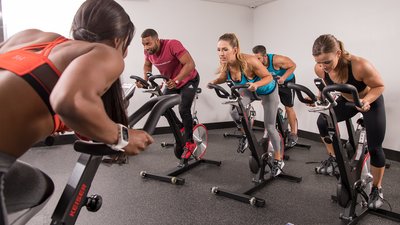Last week, the New York Times published a story detailing the alarming increase of the serious condition known as rhabdomyolysis—or "rhabdo." Rhabdo has been a hot topic in the lifting community for years, and has often been tied to CrossFit-style training and the unofficial CrossFit mascot "Uncle Rhabdo." But the article wasn't about CrossFit, it was about a group exercise class you can do in just about any commercial gym these days, with a community that spans all ages and fitness levels: spinning.[1]
What? Spin class can be dangerous? It's true. And before you laugh, realize that rhabdo is serious business. It occurs when damaged muscle tissue breaks down rapidly, and the damaged muscle cells leak their contents into the bloodstream, which is then filtered by the kidneys. This process results in brown-colored urine, intense muscle pain, and muscle weakness.
Exercise-induced rhabdomyolysis (EIR) carries potentially serious consequences, including permanent kidney damage, severe muscle damage, cardiac arrhythmia, and even death.[2,3] To make matters worse, there are no definitive pre-existing conditions to help predict whether certain individuals are at higher risk for developing rhabdo than others. Although if you have had rhabdo in the past, your chances for developing it again are significantly higher.
Not exactly what you had in mind when you hopped on the bike after work, huh? Although rhabdo is a well-documented phenomenon among the highly-trained military and emergency response personnel, the New York Times cited the growing popularity of high-intensity exercise ideologies for the sudden increase in the number of reported rhabdo cases for civilians. Here's what you need to know to avoid it.
Listen to Your Pain
In nearly every reported case, patients claimed they experienced intense muscle pain during the exercise, but kept exercising despite this warning sign. In a recent study, researchers concluded that one step toward prevention is increasing awareness and education surrounding EIR for individuals who participate in intense physical exercise, as well as those who supervise physical exercise.[4]

Additionally, these researchers found a simple perceived rate of exertion test may be useful for gauging whether the exercise was too intense and had potential to cause EIR. Although they found sustained maximum intensity exercise to be a crucial risk factor, a case study published in 2015 found that low-intensity, high-repetition exercise was the cause of EIR in a 23-year-old female.[5]
What You Can Do
It is the responsibility of both the trainee and the trainer to be aware of the potential threat of EIR. Studies show that the incidence of EIR from Fall of 2014 "coincided with the increased media attention and a new exercise trend."[3] In other words, don't leap into any new activity without a little ramp-up period.
In terms of lifting sports, experts agree novice trainees should start at a lower intensity and gradually increase intensity over time, with a recommended safe lifting load of 60-70% of 1RM performed for 3 sets of 8-12 reps to increase strength.[6,7] Don't try to out work or out lift the seasoned vets the first time you set foot in the box.
Feel lunch coming back up? Consider that another sign to check yourself. Letting a perky spandex-clad instructor adjust your resistance dial when you're already working hard, or allowing the intimidating cohorts at the local box to push you to the puking point is never a good idea.
Listen to your body, don't let yourself get bullied or intimidated into working harder than you should, and don't be afraid to stop when you feel pain.
References
- O'Connor, A. (2017, July 17). As Workouts Intensify, a Harmful Side Effect Grows More Common. Retrieved August 14, 2017, from https://www.nytimes.com/2017/07/17/well/move/as-workouts-intensify-a-harmful-side-effect-grows-more-common.html
- Tietze, D. C., & Borchers, J. (2014). Exertional rhabdomyolysis in the athlete: a clinical review. Sports Health, 6(4), 336-339.
- Rhabdomyolysis—National Library of Medicine—PubMed Health. (n.d.). Retrieved August 14, 2017, from https://www.ncbi.nlm.nih.gov/pubmedhealth/PMHT0024696/
- Apeland, T., Danielsen, T., Staal, E. M., Åsberg, A., Thorsen, I. S., Dalsrud, T. O., & Ørn, S. (2017). Risk factors for exertional rhabdomyolysis with renal stress. BMJ Open Sport & Exercise Medicine, 3(1), e000241.
- Tran, M., Hayden, N., Garcia, B., & Tucci, V. (2015). Low-intensity repetitive exercise induced rhabdomyolysis. Case Reports in Emergency Medicine, 2015.
- Khalil, M. A., & Saab, B. R. (2016). Resistance exercise-induced rhabdomyolysis: Need for immediate intervention and proper counselling. Australian Family Physician, 45(12), 898-901.
- Kraemer, W. J., Adams, K., Cafarelli, E., Dudley, G. A., Dooly, C., Feigenbaum, M. S., ... & Newton, R. U. (2002). American College of Sports Medicine position stand. Progression models in resistance training for healthy adults. Medicine and Science in Sports and Exercise, 34(2), 364-380.

